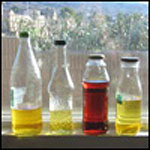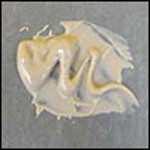
We are solitary travelers in a vast universe, consulting maps, looking for signs, hoping to figure out what it’s all about. We can only be the sum of our experiences, large, small, funny, terrifying. Existence itself is surreal and precarious and exalting and tragic. We cannot see ahead. But all creatures large and small proceed through it, even though each knows instinctively that an end is coming. It is in how we proceed through existence that counts.
Initially, I painted objects. Now I try to paint ideas.
Ever since I was a kid, I’ve been fascinated by works of the Old Masters. I loved the depictions of saints, martyrs and peasants. Additionally, I was deeply intrigued with the methods and techniques, and that intrigue continues to this day.
Of all the traditional art forms, modern oil painters interact the least with their materials. Everything is prepared for us – supports, grounds, paints, mediums and varnishes.
On the face of it, this is an advantage. But in reality, painters are deprived. Because it’s so easy to purchase ready-made supplies off the shelf, we are cheated of the abiding satisfaction that comes from a more hands-on experience of the materials of our craft. Paint manufacturers work very hard to deliver a product with a uniformly consistent texture and with an homogenous body color from one tube of paint to another. For example, we are offered generic, blended earth colors instead of a selection from the richly varied naturally occurring colors. To further complicate things, there is a wide array of student-grade paints. Sadly, such paints are to high-quality oil paint what so-called “juice drinks” are to actual juice.
Those who are curious about their materials, who are genuinely interested in how the Old Masters accomplished what they did, enter an even more bewildering maze of literature, conflicting claims, and specialized products. The 19th century was a period of intense curiosity about the techniques of the Old Masters, and the result was a large body of writings and theories, many of them now largely debunked by modern conservators, but these works – and their legacy – still command a wide audience.
After wading through the writings of respected 19th and 20th century “authorities”, after trying some of the formulas and special techniques, one finally experiences “secrets fatigue”, and decides – rightly – that those old guys didn’t actually have any special secrets. Instead, the secret was an intimate understanding of their basic materials based on generations of experience. The materials were simple: pigment, linseed or walnut oil binder, marble dust or chalk, hide glue. The use of resins was actually quite limited.
It is that very intimate acquaintance with materials that the modern painter lacks, that art schools bypass with a condescending shrug, that paint manufacturers would rather we don’t bother questioning too closely. We call that intimate acquaintance “craft”.
We live in a general social climate that wants things now, that seemingly can’t grasp the concept of patience as the key to great understanding, that has not experienced the profound peace of something as simple as kneading bread.
Art and craft inform each other. If painting is a means of personal evolution, then the craft is the fundamental basis of any personal growth. But if painting is only a means to an economic end, then the concept of craft is useless, and expediency reigns.
Pigment

Oil

There is ample evidence that oils were frequently heat-bodied. The use of sun oil was commonplace. The addition of lead changed these oils significantly. The result is oil which dries faster, yellows less, is more resinous, and delivers a greater film strength. This can all be easily done by the artist.
Oil and Chalk Putty Medium
